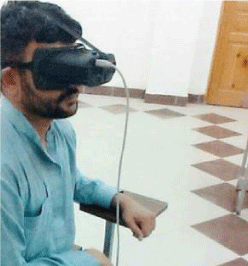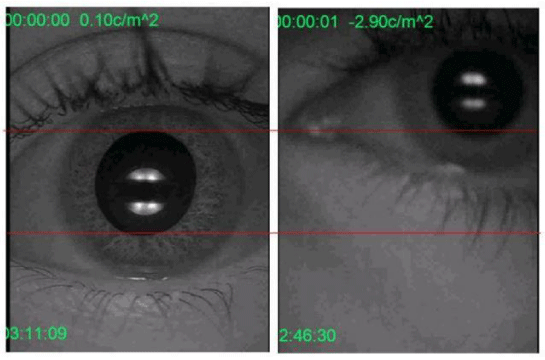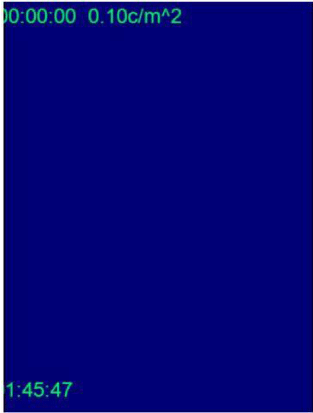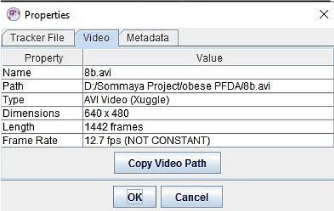Journal of Clinical Research and Ophthalmology
Beta-carotene status are co-related with pupillary diameter changes in obese & normal adults in relation to prediction of heart disease
Muhammad Jaffar Khan1, Usama1,2*, Summaya Hanif1 and Sadia Fatima1
2Institute of Chemical Sciences, University of Peshawar, Khyber Pakhtunkhwa, Pakistan
Cite this as
Khan MJ, Usama, Hanif S, Fatima S (2019) Beta-carotene status are co-related with pupillary diameter changes in obese & normal adults in relation to prediction of heart disease. J Clin Res Ophthalmol 6(2): 031-035. DOI: 10.17352/2455-1414.000061Several studies have been conducted by antioxidant properties of the Beta-carotenes in relation to their ability like prevention to coronary diseases. Similarly, 3 out of 4 randomized studies have shown that higher intakes or higher blood concentrations of β-carotenes are associated with the reduced risk of the Predictive Heart Disease (PHD). As vitamin A functions as an epithelial membrane regulator and provides immunity. In spite beta-carotene is the precursor of the vitamin A in the body, which also shows proportional relation to the body vitamin A concentration. However, beta-carotene is mostly addressing through its antioxidant properties. Similarly, a direct relation to the PHD by the pupil response effected by the pro-vitamin A have not been studied.
Result: Co-relation analysis of beta-carotene suggest significant relation to Pupillary Dynamics- Low intensity (r: 0.469, p-value 0.02) in obese adults. While, association of pupillary threshold was found significant with Pupillary Responsiveness- Low & High intensities in both the BMI groups.
Introduction
The C40 tetraterpenoid pigment also called as carotenoids are mostly found in fungi, bacteria and plants. While in mammals the carotenoids are mostly obtained through plant resources [1]. The specified conjugated polyene chromophore is not only responsible for absorption of light but also for certain photochemical properties hence it serves as a light harvesting pigment as well as photoprotective action. The antioxidizing role of the carotenoids is usually dependent on its polyene chain.
Low-Density Lipoproteins (LDL) are usually considered as good fat that circulates in the body. But if the oxidation of this LDL may take place by the increasing concentration of the free-radicals through proxy oxidative stress agents like hydrogen peroxide, then it might be considered as a potent precursor for the growth and development of atherosclerosis [2]. Now, another important aspect that was linked to the free radicals is cells reperfusion causing tissue damage to the heart walls. Similarly, to prevent these free-radicals from functioning, the indirect role of the anti-oxidants was suggested by anti-oxidant provitamin (β-carotene), vitamins C&E. The evidence regarding these phenomena shows controversial findings. Some randomized trials have shown that higher intakes of β-carotenes were related to the reduced risk of the Predictive Heart Disease (PHD) [3,4]. The supplementation trial of 333 physicians in physician Health study shows that the physicians who take high β-carotene in their diet have a low risk of cardiovascular diseases as compared to those who take low β-carotene in their diet [3]. Another study conducted on 195 Turkish patients shows that low circulating β-carotene cause cardiovascular disease in patients with low β-carotene level as compared to healthy subjects [3].
The status of vitamin A is measured in terms of pupillary threshold [5]. The psychophysical threshold testing is used to measure the dark field adaptation. Wherein the subjects are adapted to dark stimulus and then they were exposed to light stimulus. The obtained threshold is usually considered as pupillary threshold. The dark adaptations arise because of protein-energy malnutrition while some deficiencies of micronutrients are vitamin A, vitamin B, iron and zinc.
The deficiency of vitamin A usually suppresses the regeneration of Rhodopsin [6]. Rhodopsin is a covalently bounded visual pigment to 11-cis-retinal. The visual pigment rhodopsin converts 11-cis-retinal into 11-trans-retinal thus signals transduction cascade is activated [7]. The beta carotenoids are usually measured as a safer form of vitamin A as it can be helpful in regulating intestinal absorption. The analysis of beta-carotene metabolism on pupillary response revealed that the response rate is highly variable. The variation may arise because of the individual differences in the intestinal absorption rate of chylomicron metabolism [8]. The process of aging can also affect the pupillary response in many ways. The pupillary response is highly related with age because it can affect pupil size, acceleration and maximum constriction velocity but the light latency remains unaltered [9].
In hypoxic individuals the dim light also cooperates to the eye flexibility. During the World War II the fighter pilots face difficulties with their vision while flying at high altitude and hills [10]. Dark adaptation and oxygen deficiency have very close association to each other. The mild hypoxia in night vision is highly sensitive. For example patients with carotid artery disease the dark adaptation is impaired due to the reduced arterial oxygen saturation [11].
Advanced compact size pupillometer known as Portable Field dark adaptometer (PFDA) was utilized with high-goals video to record pupillary reaction with different light increments under the dull adjusted conditions. Like past gadgets, PFDA empowers the measurement of 3 factors, pupillary responsiveness (% change in pre-post diameter), pupillary threshold (≥15% change to light increment) and pupillary dynamics (Frames÷30) [10], already tested in the RCTs at rural Zambia with carotenoids biofortified maize [12]. Here we depict the benchmark co-relations between pupillary diameter changes and impact of beta-carotene (pro vitamin A), with its direct relation to the PHD.
Methodology
Study setting
The study was cross-sectionally designed, ethically approved from Ethical Review Committee KMU. The study was done at Institute of Basic Medical Sciences Khyber Medical University to observe the pupillary response of the normal and obese BMI adults in local population of Peshawar, co-relate it to beta-carotene concentrations (precursor of Vitamin A).
Study population
A total of 50 participants were recruited locally, out of which n=25 were normal BMI ≤ 25 and n=25 were obese BMI (≥ 30). The mean aged for the normal BMI was 27.68±7.53 while, obese BMI were mean aged 36.04±10.49. All the participants were having normal vision (6/6) with or without glasses and not have cataract were included.
Dark adaptometry
PFDA goggles (Figure 1) has a camera element and a solid-state flash. First the goggles were adjusted comfortably to the patient and ensures that no light is entering form outside to the goggles. Patient was addressed to please keep their eyes open and looked straight. After that the patient’s eyes were subjected to a flash of white light subsequent to allowing them to adjust at dark conditions. Stimuli of dim light, with increased in 0.4 log cd/m2 occurred at the increment of 1 second and there were a total nine sessions, also a 10 seconds rest between the session was there to re-position the pupillary constriction. At the end of the nine sessions real time monitored video were recorded and Custom developed software will use to analyze pre-and post-flash images to quantify the patient’s pupillary light reflex. Total time taken for the whole procedure for the one patient was approximately 15 minutes.
Anthropometric data
Height, weight and waist were measure according to the standard operating protocols already discuss [13]. BPM & SpO2 were measure with oximeter installed on the right index finger.
Dark adaptation video analysis
First the saved video was imported to the open source software Tracker 5.0. Measuring tool was used to observe the distance between the pre-& after stimulus response of the pupillary response to the different increment of the dim light. Pupillary response, dynamic and Pupillary threshold was measured from each video.
Beta carotene analysis
Commercially available kit Human BCO2(Beta, beta-carotene 9′,10′-oxygenase) ELISA Kit were used to analyzed beta-carotene.
Statistical analysis
Numerical data recorded from each patient was first arranged and checked for any random error in the excel sheet. Based on distribution Anderson-Darling test was applied to check whether the data attributed to the normal/parametric or non-normal/un parametric distribution of trial variables. Data expressed from probability plot were presented either Mean/St.dev or median/inter-quartile range (IQR) by descriptive statistics. Correlation of beta carotene with different variables were determined by Pearson correlations. Multi-effect linear regression models were used to associate pupillary threshold with study variables. Probability-values ≤0.05, considered significant. All the data was analyzed through Minitab Version 17 (Minitab® V. 17 USA) & Stata® version 15 (Stata® V. 15 USA).
Results
A total of 50 participants completed the trial, Table 1 suggest the demographic profile of the study participants. Age, Height, Weight, BMI, Waist Size and Beta-carotene were found significant between the two BMI groups. While percent change in pupil diameter, pupillary threshold and dynamics were not significant (Table 1). Co-relation analysis of beta-carotene with study variables suggest significant correlation with Pupillary Dynamics-Low intensity (p-value 0.02) in obese adults at Table 2. Association of pupillary threshold was found significant with Pupillary Responsiveness-Low & High intensities in both the BMI groups (Table 3).
Discussion
A total of 9 (18%) impaired pupillary threshold was found prevalent in our subjects (both BMI groups), with the highest number at obese adults i.e. 5 (10%), based on standard ≥15% pupil change suggested by Labrique et al., [10]. Pupillary threshold was not found to be positively associated with the lowered beta-carotene levels. Further supported by the study which shows beta-carotene does not improve pupillary threshold [12]. Pupillary threshold ≥15 were found strongly significant with pupillary responsiveness of low intensity (-2.9 to -1.3cd/m2) as well high intensity (-0.9 to 0.1cd/m2), in both the BMI groups indicating ≥15% change, cut off value for our population.
Because of the small percent (18%), impaired threshold in our population, the examination were focused on estimation of the pupillary light dynamics under dull adjusted conditions-in which a quicker reaction is developmentally essential for the fast location of the risk [14]. A slower pupillary reaction is corresponded with diminishing of the retinal fiber layer, which is normal for eye ailments, for example, glaucoma [15], but it was excluded by the criteria in our study. Low-beta carotene levels <0.09 umol/L, 96% were significantly co-related with the delay’s pupillary dynamics (velocity of pupil to which it reacts to external stimuli i.e. flash of light) in the obese BMI adults. However, in Normal BMI adults (<0.09 umol/L, 65.2%), we do not find as such significant correlation, possibly because of low percent of impaired beta-carotene levels, in addition to their age factor (27.68±7.53 Vs 36.04±10.49). Further, if we could say, low pupillary response in the obese BMI adults is related to the prediction of the coronary heart disease (our hypothesis), which were supported by the 3 out of 4 trials, stating beta-carotene impaired levels are associated with heart risks [4]. But at the same time one study suggest higher beta-carotene levels are neither beneficial for heart risks nor harmful [16]. Likewise, another study tells that low beta-carotene (low vitamin A levels) in the body, were only associated to lowered pupillary responsiveness of the eyes to the dark-adapted conditions, it does not improve the pupillary threshold [12]. But in our study, due to considering 3 factors, we find low-beta levels are significant with pupillary dynamic (r: 0.469, p-value 0.02), thus supporting our hypothesis. At the same time, we further recommend interventional randomized trials with cross over in weight change (obese to lean & lean to obese).
The strong positive relation between Spo2 and beta-carotene was expected. As beta-carotene are immunologically active with the uptake of 8 molar of oxygen by producing non-vitamin A products through autoxidation [17]. While, low levels of oxygen immersion (Andean highlanders), were related with altogether more pupillary responsiveness [18]. However, we couldn’t find such association.
Our investigation has limitations. Above all, we design cross-sectional study and we were un-able to control co-founding factors like person staying awake late at night [19]. Moreover, PFDA batteries backup up to 3hrs , you have to change another pair, if we are in the area where there is no electricity that may be a serious problem. The eyes are not recorded before the 10 minutes standard dark adaptation time; hence we were not aware whether the eyes were aligned with the center of the recording screen or not (Figure 2). The dark adaptometer goggles connecting wire with the controller box is of the old generation (S-type), and some time causing trouble with taking time to install however in the busy field work pressure its sometime misses, suggested to replace with HDMI and also there are blue screen issues during recording (Figure 3). Videos recording were 30 frame per second (fps) but Tracker 5.0 video analysis showing 13 fps (Figure 4) when analyzing results (skipping some of the frames). Another big issue was custom software of PFDA only accept whole numbers, but in larger scale trial it may had a problem. Some patients complain about the device such as damaging to the eye. nyctophobia, headache, dizziness and timings (15mins). But with proper counselling that small problems were resolved in BiZiFED trial as well these cross-sectional studies. PFDA is next-generation, non-invasive device. very cost effective & recyclable and useful in community having cultural taboos such as the needle would cause HIV, social challenges (reluctant in given blood) and all the hematological protocols.
In short this was a preliminary approach with this novel device (PFDA) to identify the prediction of heart risks with the limited budget and time. Here, we get a small-scale success, but further we recommend cross-over interventional trials with the addition of inflammatory biomarkers (AGP & CRP) and serum/plasma heavy metal measurements in body.
We thank Prof Nicola Lowe and Dr. M. Jaffar Khan for their support by providing PFDA device for research purposes. We also acknowledge the contributions of clinical trial room at Khyber Medical University.
- Martínez-Poveda B, Torres-Vargas JA, Ocaña MDC, García-Caballero M, Medina MÁ, et al. (2019) The Mediterranean Diet, a Rich Source of Angiopreventive Compounds in Cancer. Nutrients 11: 2036. Link: http://bit.ly/34iB5NV
- Toledo-Ibelles P, Mas-Oliva J (2018) Antioxidants in the Fight Against Atherosclerosis: Is This a Dead End? Current atherosclerosis reports 20: 36. Link: http://bit.ly/32Twgu1
- Kohlmeier L, Hastings SB (1995) Epidemiologic evidence of a role of carotenoids in cardiovascular disease prevention. Am J Clin Nutr 62: 1370S-1376S. Link: http://bit.ly/31SsOOX
- Osganian SK (2003) Dietary carotenoids and risk of coronary artery disease in women. Am J Clin Nutr 77: 1390-1399. Link: http://bit.ly/2BLixcO
- Healy K, Aguila M, Bellingham J, Li W, McCulley C, et al. (2018) Nutritional Status Measures Are Correlated with Pupillary Responsiveness in Zambian Children. J Nutr 148: 1160-1166. Link: http://bit.ly/2PpmCLJ
- Athanasiou D, Aguila M, Bellingham J, Li W, McCulley C, et al. (2018) The molecular and cellular basis of rhodopsin retinitis pigmentosa reveals potential strategies for therapy. Prog Retin Eye Res 62: 1-23. Link: http://bit.ly/2BPA0Ru
- Saari JC (2012) Vitamin A metabolism in rod and cone visual cycles. Annual review of nutrition 32: 125-145. Link: http://bit.ly/2BPC0ZL
- Bohn T (2019) β-Carotene in the human body: metabolic bioactivation pathways–from digestion to tissue distribution and excretion. Press Nutr Society 78: 68-87. Link: http://bit.ly/2Wka4GL
- Fotiou D, Brozou CG, Tsiptsios DJ, Fotiou A, Kabitsi A, et al. (2007) Effect of age on pupillary light reflex: evaluation of pupil mobility for clinical practice and research. Electromyogr Clin Neurophysiol 47: 11-22. Link: http://bit.ly/2BRmEnu
- Labrique AB, Palmer AC, Healy K, Mehra S, Sauer TC, et al. (2015) A novel device for assessing dark adaptation in field settings. BMC ophthalmology 15: 74. Link: http://bit.ly/32S13Hr
- Rantamäki AH (2011) Human tear fluid lipidome: From composition to function. PloS one 6: e19553. Link: http://bit.ly/36ceqEq
- Palmer AC, Katherine Healy, Barffour MA, Siamusantu W, Chileshe J, et al. (2016) Provitamin A Carotenoid–Biofortified Maize Consumption Increases Pupillary Responsiveness among Zambian Children in a Randomized Controlled Trial. J nutr 146: 2551-2558. Link: http://bit.ly/2PpBY2U
- Lowe NM, Khan MJ, Broadley MR, Zia MH, McArdle HJ, et al. (2018) Examining the effectiveness of consuming flour made from agronomically biofortified wheat (Zincol-2016/NR-421) for improving Zn status in women in a low-resource setting in Pakistan: study protocol for a randomised, double-blind, controlled cross-over trial (BiZiFED). BMJ open 8: e021364. Link: http://bit.ly/2Wjie2l
- Chen L, Yuan X, Xu Q, Wang Y, Jiang Y (2016) Subliminal impending collision increases perceived object size and enhances pupillary light reflex. Front Psychol 7: 1897. Link: http://bit.ly/2NiDWPJ
- Chang DS, Boland MV, Arora KS, Supakontanasan W, ChenBB, et al. (2013) Symmetry of the pupillary light reflex and its relationship to retinal nerve fiber layer thickness and visual field defect. Invest Ophthalmol Vis Sci 54: 5596-5601. Link: http://bit.ly/2WjZuQd
- Omenn GS, Goodman GE, Thornquist MD, Balmes J, Cullen MR, et al. (1996) Effects of a combination of beta carotene and vitamin A on lung cancer and cardiovascular disease. N Engl J Med 334: 1150-1155. Link: http://bit.ly/2MQIEW3
- Burton GW, Daroszewski J, Nickerson JG, Johnston JB, Mogg TJ, et al. (2014) β-Carotene autoxidation: oxygen copolymerization, non-vitamin A products, and immunological activity. Canadian Journal of Chemistry 92: 305-316. Link: http://bit.ly/2JsTGhU
- Healy K, Labrique AB, Miranda JJ, Gilman RH, Danz D, et al. (2016) Dark adaptation at high altitude: an unexpected pupillary response to chronic hypoxia in Andean highlanders. High Alt Med Biol 17: 208-213. Link: http://bit.ly/2PwhOV3
- Nagai M, Hoshide S, Kario K (2010) Sleep duration as a risk factor for cardiovascular disease-a review of the recent literature. Curr Cardiol Rev 6: 54-61. Link: http://bit.ly/2PpDoug

Article Alerts
Subscribe to our articles alerts and stay tuned.
 This work is licensed under a Creative Commons Attribution 4.0 International License.
This work is licensed under a Creative Commons Attribution 4.0 International License.




 Save to Mendeley
Save to Mendeley
